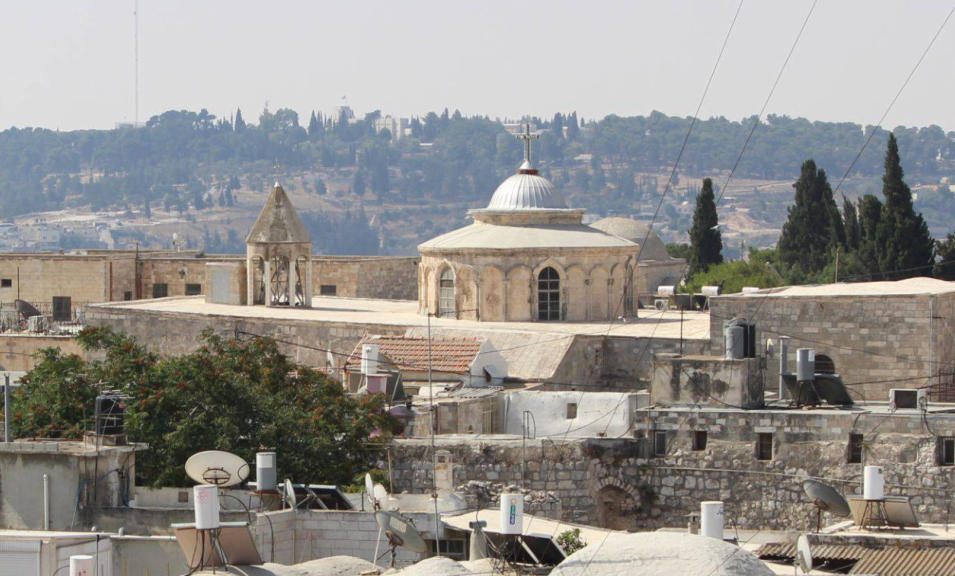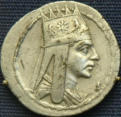

Armenian Jerusalem


It
seems
as
if
the
dust
of
centuries
has
buried
traces
of
the
once
vibrant,
and
vociferous,
community,
in
oblivion.
You
pause
for
a
moment
to
"weep
and
mourn,"
with
the
great
Jahiliya
poet
Umru
'ul
Qais,
"Qifa
nabki
fi
dhikra
habiben
wa
manzili"
("in
memory of a loved one and a home.)"
Where
are
the
garrulous
"barav"s
(old
women)
who
lined
both
sides
of
the
street,
engaged
in
exchanging
the
day's
gossip
and
shredding
the
reputations
of
rivals?
Where
are
the
squabbling
children
as
they
chase
each
other's
shadow
up
and
down
the
alleys?
Where
are
the
water-vendors,
the
scrubbing-sand
peddlers,
the
"ka'ek"
(bagels)
bakers
whose
strident cries filled the air?
And
where
is
Khoren
the
Jamgotch
who
pounded
the
cobblestones
of
your
childhood,
inviting
the
faithful
to
Sunday
prayers
at
the
Church
of
the
Holy
Archangels,
his
mellifluously evocative voice still retaining its haunting lilt?
Does
anyone
remember
the
ribald
poem
the
hapless
Michael
Kostayan
used
to
spout
at
the
drop
of
a
hat?
It
had
been
composed
and
taught
him
by
the
ragtag
band
of
vagabond
kaghakatsi
youth
who
delighted
in
teasing
him,
and
began
with
the
nonsense
verse:
"Dokh
kondeh dokh kondeh. . . "
Gone
are
the
wild
nights
of
the
Armenian
New
Year
when
the
kaghakatsis
would
all
gather
at
their
club,
the
Jerusalem
Armenian
Benevolent
Union,
have
a
drink
and
a
bite,
sing
songs
led
by
an
accordion
wielding
pied
piper
and
snake
around
the
streets
on
their
"pub crawl" to bring joy and cheer to all the homes in the Quarter.
Among
them
would
have
been
Bedros,
perhaps
the
most
uncelebrated
hero
the
Armenians
of
Jerusalem
have
ever
produced,
a
man
who
without
any
protective
armor,
had
disarmed
and
bodily
carried
away
an
unexploded
missile
that
landed
in
somebody's
kitchen
during
the
1948
Arab-Israeli
war.
The
picture
that
lingers
most
is
the
sight
of
this
diminutive
man
hugging
the
bomb
to
his
chest
as
he
manhandled
it
down
stairs,
stumbling blindly because the missile was taller than him.
Who
will
forget
the
avuncular
Apraham
Baba,
towering
over
us,
clad
in
an
Ottoman
"shirwal,"
(baggy
trousers)
as
he
sold
us
candy
and
trinkets
from
his
shop
which
disappeared
in
a
puff
of
smoke
after
a
bomb
landed
there,
or
Megerditch
the
dairy
farmer
whose
rantings
at
his
Arab
hired
help
punctuated
our
mornings?
His
spread
is
now
a Jewish housing complex.
They,
and
the
cavalcade
of
other
intriguing
characters
that
animated
the
idyll
of
this
community
(dubbed
"kaghakatsi,"
city
or
native
dwellers)
in
the
Armenian
Quarter
of
Jerusalem,
have
long
gone
their
way,
but
the
memory
lingers,
and
will
linger
as
long
as
this tiny enclave remains on the map.
For
under
every
cobblestone
carpeting
the
ancient
alleys,
lies
a
tale
to
be
told,
of
heroes
and
villains,
of
tears
and
laughter,
of
love
and
hope,
of
glory
and
disaster.
And
you
would
never
get
lost
in
the
Armenian
Quarter,
for
every
household
had
its
own
personal
signpost,
a
nickname
based
on
some
distinct
incident
or
characteristic:
"dar
el
'ajayez,"
the
home
of
the
old
ones;
"dar
el
tasseh,"
the
home
of
the
bowl;
"dar
el
hattiti,"
the
door
of the bolt . . .
But
the
kaghakatsi
have
a
stronger
claim
to
a
cherished
niche
in
the
annals
of
the
Old
City:
their
claim
to
immortality
will
probably
be
ensured
not
solely
by
virtue
of
their
expressive
history,
but
by
an
anthropological
or
genealogical
rarity:
every
single
kaghakatsi is related by blood to another kaghakatsi.
The
whole
kaghakatsi
community
is
a
spiderweb
of
family
relations.
If
you
are
not
my
cousin, you are my cousin's cousin.
It
would
not
be
uncommon
for
two
kaghakatsis
from
totally
different
families
to
stumble
upon
a
common
ancestor
going
back
several
decades
or
even
a
century
or
more.
Along
the
way,
this
lively
community
(at
its
peak
it
numbered
1,000)
has
given
the
world
photographers,
teachers,
artists,
writers,
scholars,
craftsmen,
philosophers
and
musicians, among others, paramount among them the composer Ohan Dourian.
Attrition
has
seriously
depleted
their
ranks
over
the
years,
and
only
a
handful
of
stalwarts now remains to man the fort and hold the flag.
"We
are
few,
what's
left
of
us,
but
we
carry
in
our
genes
the
long
cherished
memories
and
traditions
of
a
glorious
past.
And
the
hope
is
always
that
we
shall
pass
these
on
to
our children," as one kaghakatsi resident noted.
His
compatriots
have
taken
a
bold
and
ambitious
step
forward
with
the
launching
of
a
project
to
map
out
the
genealogical
history
of
the
kaghakatsis,
creating
a
kaghakatsi
family tree, for the first time ever.
"It's
probably
too
late,
with
all
the
oldsters
long
departed,
taking
along
their
memories
and
stories
with
them,
but
we're
going
to
backtrack
as
far
as
we
can
go,
delving
into
the
memory
banks
of
grandparents,
uncles,
aunts,
whoever,"
the
organizers
note.
While
documented
records
are
sparse,
the
Armenian
Patriarchate
of
Jerusalem
houses
an impressive archive of family histories dating back to a little more than 200 years.
Beyond
that,
it's
all
shrouded
in
mystery:
Armenians
have
been
coming
to
Jerusalem
ever since the 5th Century.
The
organizers
have
gathered
genealogical
details
of
all
current
Kaghakatzis
living
around the world, and entering these into a computer database.
"Because
all
the
old
kaghakatsi
families
were
related,
it's
logical
to
assume
that
they
had a common ancestor, perhaps more than one," the organizers believe.
The
project
has
yielded
interesting
results.
Tamar
Schlekhat,
living
in
the
USA,
can
now
quickly
take
herself
back
a
hundred
years
to
her
paternal
grandfather's
days,
and
discover
a
wealth
of
relatives,
literally
all
over
the
world,
she
never
expected
to
know
about.
"It's unbelievable, the kaghakatsis are all one big network of relatives," she enthuses.
The
project
is
an
on-going
one
as
more
names
are
added
to
the
database,
more
pictures
are
uncovered
and
more
anecdotes
remembered,
creating
a
living
genealogical
depository future generations can tap in.
"It
will
be
a
live
project
because
future
generations
can
continue
to
add
to
it,"
the
organizers say.
While
the
aim
has
been
to
concentrate
on
the
Armenian
kaghakatsis,
odar's
(non-
Armenians)
also
make
a
cameo
appearance
in
the
database,
but
there
have
been
no
attempts to trace their ancestry.
"Otherwise, it would have become unmanageable," the organizers say.
As you walk along the ancient cobblestones of the twisting
and turning alleys of the Armenian Quarter of the Old City of
Jerusalem, you are struck by the eerie silence that seems to
have settled everywhere.



St James compound






















